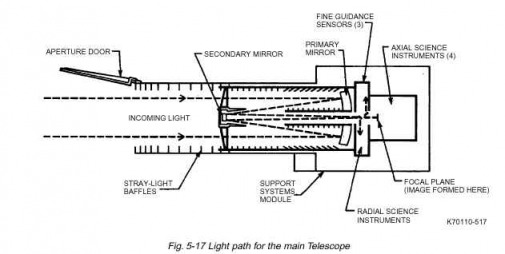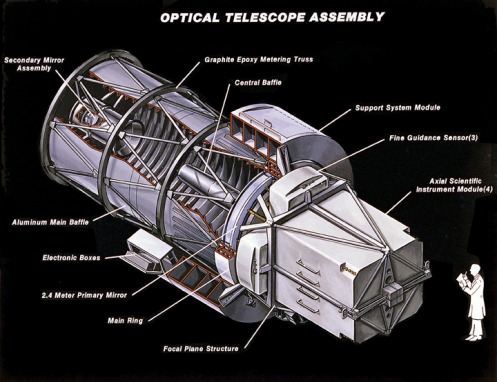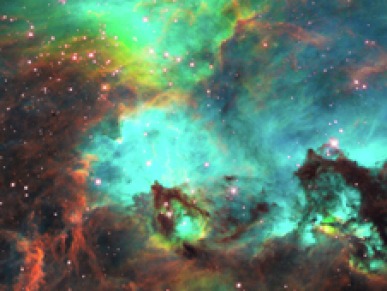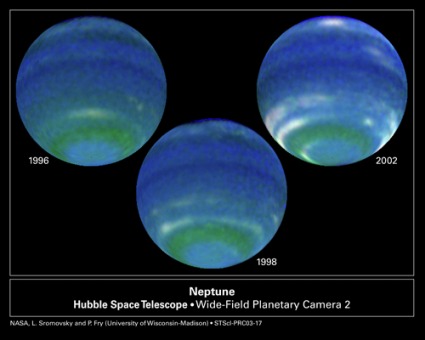Hubble Spacecraft Telescope, Celebration April 25, 2010 of 2 Decades of Looking at the Universe

Hubble Telescope, Primary, Secondary Mirror Systems for Focusing Light and Forming an Image
This April 25 of 2010, is the 20th year of the Hubble telescope's many successful space observations and data acquisitions (original Hubble spacecraft telescope launch — April 25, 1990). Because the Hubble telescope is beyond the interference of earth's atmosphere, the telescope can gather unobstructued visible, near-ultraviolet and near-infrared light spectra. This unique space telescope can gather all the radiations with great precision, and has provided astronomers with the best images of the cosmos ever seen.
Hubble Telescope, Anatomy and Important Features of the Telescope and Spacecraft

Hubble Telescope, Optical TA, Support Systems Module, Science Instrument C & Data H
Following are 4 Important Features of the Hubble Spacecraft Telescope (HST):
1. Support Systems Module (SSM), provides electrical power, data communications, pointing control, maneuvering.
2. The Optical Telescope Assembly (OTA), collects and concentrates incoming light in the focal plane for detection and interpretation by the onboard instruments.
3. Eight major science instruments are onboard, 4 are in the rear section focal plane structure (FPS), and 4 are installed around the spacecraft's circumference. The Science Instrument Control and Data Handling (SI C&DH) Unit controls all instruments with the exception of the Fine Guidance Sensors (FGS).
4. There are 2 Solar Arrays (SA) for generation of electrical power and charging onboard batteries. Communications antennas receive command signals and send telemetry data from the HST back to earth.
1. Support Systems Module (SSM), provides electrical power, data communications, pointing control, maneuvering.
2. The Optical Telescope Assembly (OTA), collects and concentrates incoming light in the focal plane for detection and interpretation by the onboard instruments.
3. Eight major science instruments are onboard, 4 are in the rear section focal plane structure (FPS), and 4 are installed around the spacecraft's circumference. The Science Instrument Control and Data Handling (SI C&DH) Unit controls all instruments with the exception of the Fine Guidance Sensors (FGS).
4. There are 2 Solar Arrays (SA) for generation of electrical power and charging onboard batteries. Communications antennas receive command signals and send telemetry data from the HST back to earth.
Nebula Definition and Types – Emission, Absorption and Reflection Nebulas

Tarantula Nebula, 170,000 Light-Years Away, Hubble Telescope View
The Hubble telescope has opened scientists' and humanity's eyes to the vastness and the magnificence of space. This surreal photograph of a distant nebula captures with unbelievable beauty and rich colors a scene suitable for framing and placement in a museum of great works of art.
And just what is a nebula? A nebula is a diffuse mass of interstellar dust or gas, or both dust and gas. The nebula may absorb UV radiation from stars and emit light at a longer wavelengths — this is called an emission nebula; if the nebula simply reflects incident light from stars it is called a reflection nebula; if the nebula absorbs all the incident radiation and does not emit any radiation it is an absorption nebula. A nebula may show all 3 features in different regions: emission, reflection, absorption.
The Tarantula nebula (NGC 2070) is approximately170,000 light-years away and 100-light-years wide. The Taratula nebula is on the edge of a dark, molecular cloud and is near the star cluster NGC 2074. The region may have been created by a nearby supernova explosion and is in the Large Magellanic Cloud, a satellite of our Milky Way galaxy. The Tarantula nebula is a star-formation and star-evolution region — one text describes it as a "star factory" (Atlas of the Universe, by M.A. Garlick). Dwarf galaxies like the Large Magellanic Cloud are believed to be primitive building blocks for larger galaxies. The seahorse-shaped pillar of the Tarantula nebula (lower, right in the photo here) is about 20 light-years long, or 4X the distance between our sun and Alpha Centauri, the next nearest star beyond our sun (a star).
Hubble images of the Tarantula nebula reveal ridges and valleys of dust, and gaseous glowing emissions of light filaments energized by intense ultraviolet radiation. High-energy radiation from clusters of hot young stars is slowly breaking down the wall of the nebula. Another young star cluster may lie under the circle of brilliant blue gas shown in the Hubble photo.
And just what is a nebula? A nebula is a diffuse mass of interstellar dust or gas, or both dust and gas. The nebula may absorb UV radiation from stars and emit light at a longer wavelengths — this is called an emission nebula; if the nebula simply reflects incident light from stars it is called a reflection nebula; if the nebula absorbs all the incident radiation and does not emit any radiation it is an absorption nebula. A nebula may show all 3 features in different regions: emission, reflection, absorption.
The Tarantula nebula (NGC 2070) is approximately170,000 light-years away and 100-light-years wide. The Taratula nebula is on the edge of a dark, molecular cloud and is near the star cluster NGC 2074. The region may have been created by a nearby supernova explosion and is in the Large Magellanic Cloud, a satellite of our Milky Way galaxy. The Tarantula nebula is a star-formation and star-evolution region — one text describes it as a "star factory" (Atlas of the Universe, by M.A. Garlick). Dwarf galaxies like the Large Magellanic Cloud are believed to be primitive building blocks for larger galaxies. The seahorse-shaped pillar of the Tarantula nebula (lower, right in the photo here) is about 20 light-years long, or 4X the distance between our sun and Alpha Centauri, the next nearest star beyond our sun (a star).
Hubble images of the Tarantula nebula reveal ridges and valleys of dust, and gaseous glowing emissions of light filaments energized by intense ultraviolet radiation. High-energy radiation from clusters of hot young stars is slowly breaking down the wall of the nebula. Another young star cluster may lie under the circle of brilliant blue gas shown in the Hubble photo.
Neptune Seasonal Cloud Changes Reflected by Hubble Telescope Observations, 1996 to 2002

Neptune Planet Shows Seasonal Changes to Hubble Telescope as It Orbits the Sun
Neptune appears as an icy blue planet, (or, a blue-green dot as seen through binoculars). Neptune takes 164.79 years to orbit the sun, compared to earth's speedy orbit of the sun in 365 days or 1 year. Earth is 93 million miles away from the sun, Neptune is 2,793.1 million miles (4,495.1 km) away from our sun and star. Neptune receives only 0.1 % of the sunlight received by earth.
When Neptune is looked at more closely it was both interesting to see that Neptune showed distinct changes from 1996 to 2002. Check the progress of the 3 different year time frames captured in the photos here. What is seen in these photos? Observe. Now, hypothesize, what could be happening as shown? What explanations about Neptune can be offered or hypothesized?
Earth's atmosphere is 78 % nitrogen gas and 21 % oxygen, with 0.03 % CO2. Neptune's atmosphere is 79 % hydrogen gas, 18% helium and 3 % methane. The clouds on Neptune are mainly ice forms of methane and ammonium hydrosulfide, and Neptune has strong winds and violent storms. Ice clouds are most prominent in the southern hemisphere.
VISIT Our Science Super School Store
All the Written Material within Site is Copyrighted 2010 and Owned by Dr. Donald Reinhardt, and this original material is protected legally by this copyright notice and by the Digital Millennium Act. None of this original material may be copied or reproduced without the expressed written consent of the author.
The author is a Freelance Science writer, and is available for specific assignments for those who are interested – by contacting adminstrator@sciencesuperchool.com. Other questions related to this teaching site should be directed to teacher@sciencesuperschool.com.
When Neptune is looked at more closely it was both interesting to see that Neptune showed distinct changes from 1996 to 2002. Check the progress of the 3 different year time frames captured in the photos here. What is seen in these photos? Observe. Now, hypothesize, what could be happening as shown? What explanations about Neptune can be offered or hypothesized?
Earth's atmosphere is 78 % nitrogen gas and 21 % oxygen, with 0.03 % CO2. Neptune's atmosphere is 79 % hydrogen gas, 18% helium and 3 % methane. The clouds on Neptune are mainly ice forms of methane and ammonium hydrosulfide, and Neptune has strong winds and violent storms. Ice clouds are most prominent in the southern hemisphere.
VISIT Our Science Super School Store
All the Written Material within Site is Copyrighted 2010 and Owned by Dr. Donald Reinhardt, and this original material is protected legally by this copyright notice and by the Digital Millennium Act. None of this original material may be copied or reproduced without the expressed written consent of the author.
The author is a Freelance Science writer, and is available for specific assignments for those who are interested – by contacting adminstrator@sciencesuperchool.com. Other questions related to this teaching site should be directed to teacher@sciencesuperschool.com.